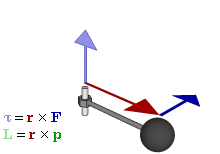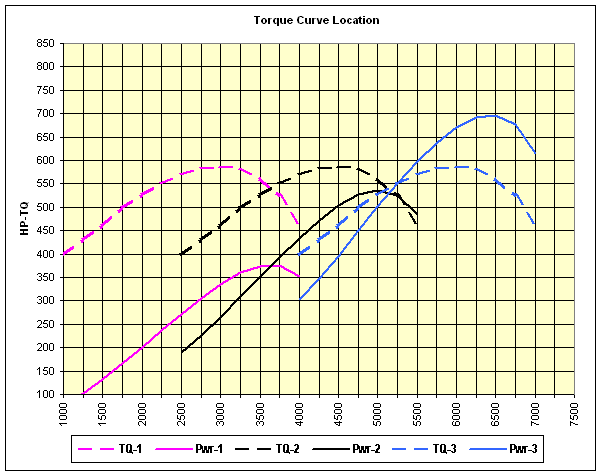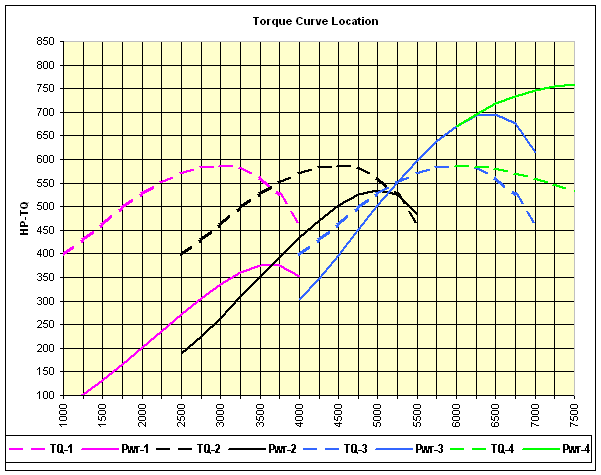Measuring Power
A
dynamometer determines the
POWER an engine produces by applying a
load to the engine output shaft by means of a water brake, a generator, an eddy-current absorber, or any other controllable device capable of absorbing power. The dynamometer control system causes the absorber to exactly match the amount of
TORQUEthe engine is producing at that instant, then
measures that
TORQUE and the
RPM of the engine shaft, and from those two measurements, it calculates
observed power. Then it applies various factors (air temperature, barometric pressure, relative humidity) in order to
correct the
observed power to the value it
would have been if it had been measured at standard atmospheric conditions, called
corrected power.
Designing an engine
In order to design an engine for a particular application, it is helpful to plot out the optimal power curve for that specific application, then from that design information, determine the torque curve which is required to produce the desired power curve. By evaluating the torque requirements against realistic
BMEP values you can determine the reasonableness of the target power curve.
SEE BMEP FURTHER DOWN THE PAGE
Typically, the torque peak will occur at a substantially lower RPM than the power peak. The reason is that, in general, the torque curve does not drop off (%-wise) as rapidly as the RPM is increasing (%-wise). For a race engine, it is often beneficial ( within the boundary conditions of the application ) to operate the engine well beyond the power peak, in order to produce the maximum average power within a required RPM band.
However, for an engine which operates in a relatively narrow RPM band, such as an aircraft engine, it is generally a requirement that the engine produce maximum power at the maximum RPM. That requires the torque peak to be fairly close to the maximum RPM. For an aircraft engine, you typically design the torque curve to peak at the normal cruise setting and stay flat up to maximum RPM. That positioning of the torque curve would allow the engine to produce significantly more power if it could operate at a higher RPM, but the goal is to optimize the performance within the operating range.
An example of that concept is shown Figure 3 below. The three dashed lines represent three different torque curves, each having exactly the same shape and torque values, but with the peak torque values located at different RPM values. The solid lines show the power produced by the torque curves of the same color.
Figure 3
Note that, with a torque peak of 587 lb-ft at 3000 RPM, the pink power line peaks at about 375 HP between 3500 and 3750 RPM. With the same torque curve moved to the right by 1500 RPM (black, 587 lb-ft torque peak at 4500 RPM), the peak power jumps to about 535 HP at 5000 RPM. Again, moving the same torque curve to the right another 1500 RPM (blue, 587 lb-ft torque peak at 6000 RPM) causes the power to peak at about 696 HP at 6500 RPM
Using the black curves as an example, note that the engine produces 500 HP at both 4500 and 5400 RPM, which means the engine can do the same amount of work per unit time (power) at 4500 as it can at 5400. HOWEVER, it will burn less fuel to produce 450 HP at 4500 RPM than at 5400 RPM, because the parasitic power losses (power consumed to turn the crankshaft, reciprocating components, valvetrain) increases as the square of the crankshaft speed.
The RPM band within which the engine produces its peak torque is limited. You can tailor an engine to have a high peak torque with a very narrow band, or a lower peak torque value over a wider band. Those characteristics are usually dictated by the parameters of the application for which the engine is intended.
An example of that is shown in Figure 4 below. It is the same as the graph in Figure 3 (above), EXCEPT, the blue torque curve has been altered (as shown by the green line) so that it doesn't drop off as quickly. Note how that causes the green power line to increase well beyond the torque peak. That sort of a change to the torque curve can be achieved by altering various key components, including (but not limited to) cam lobe profiles, cam lobe separation, intake and/or exhaust runner length, intake and/or exhaust runner cross section. Alterations intended to broaden the torque peak will inevitable reduce the peak torque value, but the desirability of a given change is determined by the application.
Figure 4
BMEP
Brake Mean Effective Pressure (BMEP) is another very effective yardstick for comparing the performance of an engine of a given type to another of the same type, and for evaluating the reasonableness of performance claims or requirements.
The definition of BMEP is: the average (mean) pressure which, if imposed on the pistons uniformly from the top to the bottom of each power stroke, would produce the measured (brake) power output.
Note that BMEP is purely theoretical and has nothing to do with actual cylinder pressures. It is simply a tool to evaluate the efficiency of a given engine at producing torque from a given displacement.
A torque output of 1.0 lb-ft per cubic inch of displacement in a 4-stroke engine equals a BMEP of 150.8 psi. In a 2-stroke engine, that same 1.0 lb-ft of torque per cubic inch is a BMEP of 75.4 psi.
By looking at equations 8-a and 8-b below, you can easily see that BMEP is simply the torque per cubic inch of displacement, multiplied by a constant. In fact, many talented people in the engine design and developmeny business currently use torque-per-cubic inch ("torque ratio") instead of BMEP, thereby avoiding that tedious multiplication process.
(The discussion on the remainder of this page is with respect to four-stroke engines, but it applies equally to two stroke engines if you simply substitute 75.4 everywhere you see 150.8)
If you know the torque and displacement of an engine, a very practical way to calculate BMEP is:
BMEP (psi) = 150.8 x TORQUE (lb-ft) / DISPLACEMENT (ci)
(Equation 8-a, 4-Stroke Engine)
BMEP (psi) = 75.4 x TORQUE (lb-ft) / DISPLACEMENT (ci)
(Equation 8-b, 2-Stroke Engine)
(IF you prefer pressure readings in Bar rather than PSI, simply divide PSI by 14.5)
Using BMEP to compare F1 and NASCAR engines
An F1 engine is purpose-built and essentially unrestricted. For 2006, the rules required a 90° V8 engine of 2.4 liters displacement (146.4 CID) with a maximum bore of 98mm (3.858) and a required bore spacing of 106.5 mm (4.193). The resulting stroke to achieve 2.4 liters is 39.75 mm (1.565) and is implemented with a 180° crankshaft. The typical rod length is approximately 4.016 (102 mm), for a Rod / Stroke ratio of about 2.57. These engines are typically a 4-valve-per cylinder layout with two overhead cams per bank, and pneumatic valvesprings. In addition to the few restrictions stated above, there are the following additional restrictions: (a) no beryllium compounds, (b) no MMC pistons, (c) no variable-length intake pipes, (d) one injector per cylinder, and (e) the requirement that one engine last for two race weekends.
At the end of the 2006 season, most of these F1 engines ran up to 20,000 RPM in a race, and made in the vicinity of 750 HP. One engine for which I have the figures made 755 BHP at an astonishing 19,250 RPM. At a peak power of 755 HP, the torque is 206 lb-ft and peak-power BMEP would be 212 psi. (14.63 bar). Peak torque of 214 lb-ft occurred at 17,000 RPM for a BMEP of 220 psi (15.18 bar). There can be no argument that 212 psi at 19,250 RPM is truly amazing.
However, let's look at some astounding domestic technology.
The NASCAR CUP race engine is a severely-restricted powerplant, allegedly being derived from "production" components, although as of 2010, all 4 engines competing at that level (Chevy, Dodge, Ford, Totota) are purpose-built race engines designed specifically to NASCAR's rule book.
By regulation, CUP engines have a maximum displacement of 358 CI (5.87 L). They must use a cast-iron 90° V8 block with a 4.500 inch bore spacing and a 90° steel crankshaft. A typical configuration has a 4.185" bore with a 3.25" stroke and a 6.20" conrod (R/S = 1.91). Cylinder heads are similarly purpose-designed and highly-developed, but limited to two valves per cylinder, specific valve angles, specific port floor heights, etc.. The valves are operated by a single, block-mounted, flat-tappet camshaft (that's right, still no rollers as of 2012) and a pushrod / rocker-arm / coil-spring valvetrain. It is further hobbled by the requirement for a single four-barrel carburetor (until 2011) and now (2012 on), by a 4-barrel-carburetor-like throttle body and individial runner EFI. Electronically-controlled ignition is allowed (as of 2012), and there are minimum weight requirements for the conrods and pistons.
How does it perform? In early 2010, the engines were producing in the neighborhood of 860 HP at 9000 RPM, and they operate at a max race rpm in the vicinity of 9400 rpm. That max rpm is controlled by a NASCAR rule that specifies the final drive ratio at each track (the "gear rule"). If it were not for the gear rule, these engines would be operating at well over 10,000 rpm at the race track..
Consider the fact that, to produce 860 HP at 9000 RPM, requires 501 lb-ft of torque, for a peak-power BMEP of nearly 211 PSI (14.55 bar). Peak torque (2010) was typically about 535 lb-ft at 7800 RPM, for a peak BMEP of over 226 psi (15.6 bar, torque ratio of 1.50).
THAT is truly astonishing. Compare the F1 engine figures to the CUP engine figures for a better grip on just how clever these CUP engine guys are. In addition, consider the fact that (a) a single engine must be used for each race meeting, which includes at least two practice sessions, a qualifying session, and the race, which can be as long as 600 miles, and (b) the Penske-Dodge engines that won the 2012 championship did not suffer a single engine failure throughout the 2012 38-race season.
That being said, recent winners in the annual Engine Masters competition are achieving over 16.9 bar BMEP (245 psi, torque ratio of 1.63 ! ) with normally-aspirated, petrol-fueled, SI, 2-valve pushrod engines, although the builders freely admit that, due to the very aggressive cam profiles, rocker ratios, gross valve lift numbers, and other compromises aimed at maximizing BMEP, these engines have relatively short life expectancies.
To appreciate the value of this comparison tool, suppose someone offers to sell you a 2.8 liter (171 cubic inch) Ford V6 which allegedly makes 230 HP at 5000 RPM, and is equipped with the standard OEM iron heads and an aftermarket intake manifold and camshaft. You could evaluate the reasonableness of this claim by calculating (a) that 230 HP at 5000 RPM requires 242 lb-ft of torque (230 x 5252 ÷ 5000), and (b) that 242 lb-ft. of torque from 171 cubic inches requires a BMEP of 213 PSI (150.8 x 242 ÷ 171).
You would then dismiss the claim as preposterous because you know that if a guy could do the magic required to make that kind of performance with the stock heads and intake design, he would be renowned as one of the pre-eminent engine gurus in the world. (You would later discover that the engine rating of "230" is actually "Blantonpower", not Horsepower.)
the above is a compillation of articles selected and stiched from
http://www.epi-eng.com/
read the complete comparison article on F1 and NASCAR engines
here








 So much to be learned here, thank you so much for taking the time to put this together for us. A very valuable resource for sure, much appreciated my good friend...you are the man.
So much to be learned here, thank you so much for taking the time to put this together for us. A very valuable resource for sure, much appreciated my good friend...you are the man.  Thanks to all friends for their kind comments, I know there's a lot of stuff packed in here, so take your time to digest it, and feel free to ask for anything that needs further explanation or clarification.
Thanks to all friends for their kind comments, I know there's a lot of stuff packed in here, so take your time to digest it, and feel free to ask for anything that needs further explanation or clarification. le me fix i ...
le me fix i ... ....💡 Thanks Mitch!!!
....💡 Thanks Mitch!!!  . I kept heavily tuning cars that I owned, don't think pimp style tuning, but rather racing tuning (as far as Group A) in original "unsuspecting" bodywork. Anyway I'm 48 now and still find "knowing how things work" more fascinating than ever!
. I kept heavily tuning cars that I owned, don't think pimp style tuning, but rather racing tuning (as far as Group A) in original "unsuspecting" bodywork. Anyway I'm 48 now and still find "knowing how things work" more fascinating than ever!